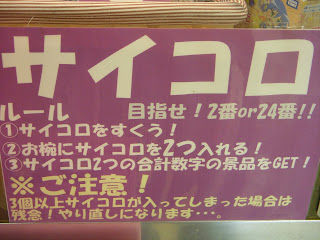I’m addicting to a lot of Japanese pop culture. Anime, tokusatsu, j-pop, and now crane games. It makes sense, after all crane games combine the skill and precision of a video game with the instant payoff of a toy or stuffed animal. I’ve become pretty good at them actually, and now I want to impart a few things I have learned the hard way, so maybe next time you visit Japan you won’t blow all your money trying to win that oversized matsuri circle cat.
Tip #1: Location, Location, Location
Where you play crane games can be every bit as important as how you play them. Look for smaller arcades that are staffed by just a few people. The reasons for this are many. Smaller stores are more likely to offer you help with the machines, literally opening them up and resetting the toys in a better position.
They are also more likely to switch out prizes for you, not only moving the prizes around inside one machine, but trading out a prize from one machine for a similarly sized/priced toy from another. The reason for all this help is simple: these stores want your business. The ones located under a Tsutaya or Taiyo already get enough traffic by virtue of being near big name stores. Furthermore, I believe the small number of pachinko machines they all seem to have toward the back sustain these smaller stores.
Tip #2: Only One Prize is Winnable
 |
| Hint: It's the Blue One |
With precious few exceptions, there will only be one prize in the stuffed animal machines that you have even the slightest chance of winning. Look for one near to or hanging over the goal. Unlike American machines, you won’t be able to actually lift any of the prizes. Instead, you should try to push them toward the goal. Notice in the picture above how the right arm of the crane hangs down lower than the left. It won't be able to pinch or lift anything. Try to get the closer arm just to the other side of the prize rather than squaring up the claw in the hopes of grabbing it.
Tip #3: Know the Rules
There are a wide variety of crane games in Japan. I’ve played ones where you have to get a pair of glasses to fall off a bar, get bouncing balls to fall into various containers, release marbles into a plinko-like board, and drop dice into a ceramic bowl.
The point here is that the goal of any given game may not be readily apparent, and the rules, while often written on the machine, are obviously in Japanese. The one above explains that you have to get exactly two dice into the bowl and will get a prize based off the total number. Any more than two and you should call over one of the workers to reset it. Not knowing the rules can sometimes lead to wasted games, so it pays to watch a few people play before you try so you can see what they do.
Tip #4: Play For What You Can Win, Not What You Like
It may be tempting to throw a lot of money at the machines where you can win a PSP, DS, or MP3 player, but by and large those prizes are more expensive because the machines are much, much harder to win. If you see something you like, you should give the machine a shot, but if you can tell the game is rigged or simply too difficult, stop and go somewhere else. I’m not saying to play games with prizes you don’t want, just that it’s better to think in terms of if you can win, not whether or not you like the prize.
 |
| Presents! |
Tip #5: Know When To Quit
As I’ve said, these games can get incredibly addictive. Part of knowing how to play is knowing when to quit. Set a cap for yourself or find some other way to limit the amount of money you spend. I usually spend only 1000 yen per visit to any given shop, or about ten US dollars. Still, I rarely walk out without having won something. Hopefully, if you’re ever in Japan and can actually use this advice, you will find luck playing these games too. And now, a cavalcade of prizes:
 |
| Cute Chopper |
 |
| Nightmare Chopper |
 |
| Probably My Favorite Prize Thus Far |
 |
| FMA Tumbler |
 |
| The Care-Bear Stitch Army |
 |
| Quality Control? What's that? |














